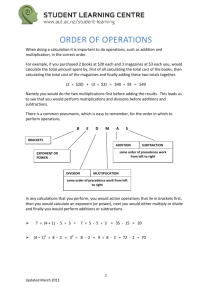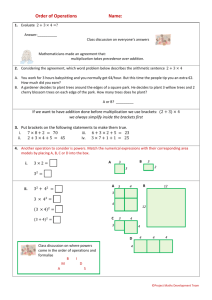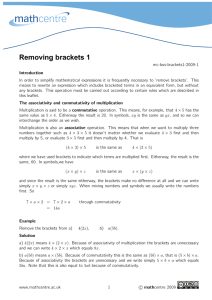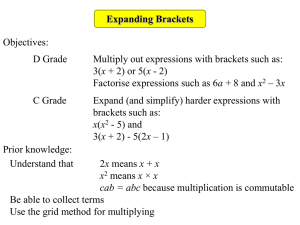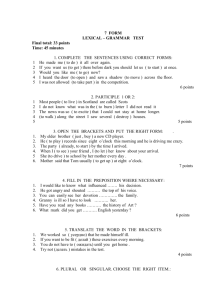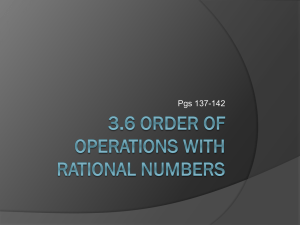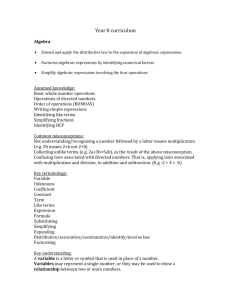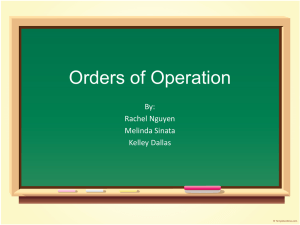Order of Operations (Priority Rules for Arithmetic)
advertisement
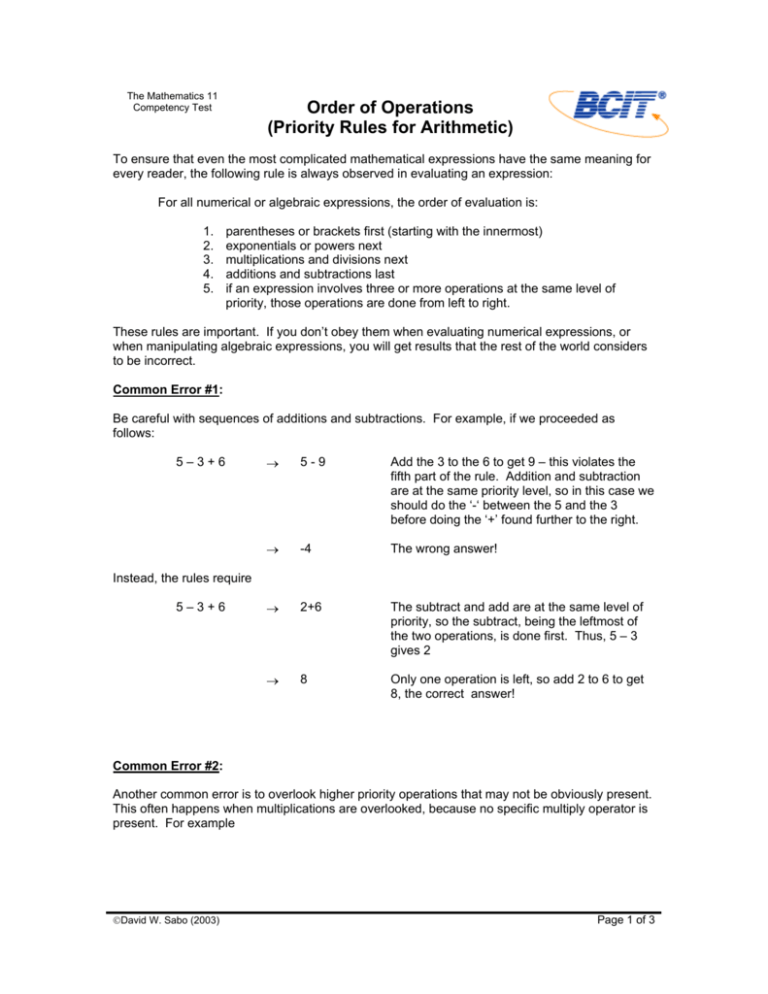
The Mathematics 11 Competency Test Order of Operations (Priority Rules for Arithmetic) To ensure that even the most complicated mathematical expressions have the same meaning for every reader, the following rule is always observed in evaluating an expression: For all numerical or algebraic expressions, the order of evaluation is: 1. 2. 3. 4. 5. parentheses or brackets first (starting with the innermost) exponentials or powers next multiplications and divisions next additions and subtractions last if an expression involves three or more operations at the same level of priority, those operations are done from left to right. These rules are important. If you don’t obey them when evaluating numerical expressions, or when manipulating algebraic expressions, you will get results that the rest of the world considers to be incorrect. Common Error #1: Be careful with sequences of additions and subtractions. For example, if we proceeded as follows: 5–3+6 → 5-9 Add the 3 to the 6 to get 9 – this violates the fifth part of the rule. Addition and subtraction are at the same priority level, so in this case we should do the ‘-‘ between the 5 and the 3 before doing the ‘+’ found further to the right. → -4 The wrong answer! → 2+6 The subtract and add are at the same level of priority, so the subtract, being the leftmost of the two operations, is done first. Thus, 5 – 3 gives 2 → 8 Only one operation is left, so add 2 to 6 to get 8, the correct answer! Instead, the rules require 5–3+6 Common Error #2: Another common error is to overlook higher priority operations that may not be obviously present. This often happens when multiplications are overlooked, because no specific multiply operator is present. For example David W. Sabo (2003) Page 1 of 3 3 + 5(10 – 6) → 8(10 – 6) Add the 3 and the five to the left. This is an error, because the 5 itself is to be multiplied onto the result of evaluating the bracketed expression, and both the evaluation of the bracketed expression and the multiplication are higher priority than the addition. The ‘+’ between the 3 and 5 is the lowest priority according to the rule, and yet was done first here in error → 8(4) Evaluate the bracketed expression → 32 which is an incorrect final result. Instead, the evaluation of this expression should have proceeded as follows: 3 + 5(10 – 6) → 3 + 5(4) Evaluate the bracketed expression – this is the highest priority operation present → 3+20 Do the multiplication – it has higher priority than the addition → 23 Finally, do the remaining addition, to get the correct final result of 23. One way to remember this operation priority rules is to use the acronym BEDMAS, meaning B (rackets) first E (xponents) next M (ultiply) and D (ivide) next and A (dd) and S (ubtract) last of all. Here are a few more examples: example: 35 x 16 – 96 + 14 David W. Sabo (2003) = 560 – 96 + 14 Do the single multiply first – it has the highest priority present. = 464 + 14 Do the left-most of the two add/subtract operations. They have the same level of priority, so the left-most one is done first = 478 Finally, do the remaining addition, to get the correct final result of 478. Page 2 of 3 example: 3 – 5(4 – 6 x 2 – 5 + 7) + 8 x 3 = 3 – 5(4 – 12 – 5 + 7) + 8 x 3 We need to start with the expression inside the brackets, which has the highest priority. Inside the brackets, the multiply operation has the highest priority. = 3 – 5(-8 – 5 + 7) + 8 x 3 Now, do the leftmost subtract inside the brackets, since the two subtracts and one add otherwise are at the same priority level. = 3 – 5(-13+7) + 8 x 3 Again, leftmost subtract inside the brackets. = 3 – 5(-6) + 8 x 3 And, the last add in the brackets. = 3 +30 + 24 Both of the multiplies are at the same priority level – here they don’t interfere with each other, so we can do both at the same step. We can regard the first one as being -5 times -6, giving the positive result +30. = 33 + 24 Now the remaining two adds can be done to get the final answer. = 57 We’ve shown the steps above in a little more detail than one might normally employ, just to show the application of the priority rules very precisely. example: 2 – 5(6 – 9)3 David W. Sabo (2003) = 2 – 5(-3)3 Evaluation of the bracketed expression takes priority over every other operation present. = 2 – 5 x (-27) The exponentiation is done next, since it is the highest priority of the remaining operations. The power 3 is applied to the entire contents of the brackets: (-3) x (-3) x (-3) = 2 + 135 The multiplication has the next highest priority. = 137 Page 3 of 3
